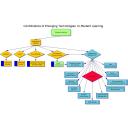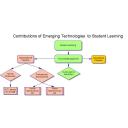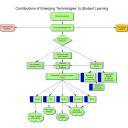Infrastructure Management
May 6, 2007 at 11:01 pm | Posted in Infrastructure Managment | Leave a commentThe Infrastructure Management Matrix describes the contributions a candidate technology makes to the improvement of student learning. Entries to the database capture the requirements to support emerging technologies including:
- Computers and digital devices
- Network security and filtering
- Wireless technologies
- Operating systems
- Assistive technologies/Universal Design for Learning
- Data warehousing
- Server technologies
- Data storage
- Digital rights management
- Communication/collaboration systems
- Network performance management
Candidate technologies which address more than one category or subcategory should be entered as many times as needed under the categories involved. For example, Second Life might be entered under communication/collaboration systems and Network security and filtering.
Operational Capacity
May 6, 2007 at 10:55 pm | Posted in Operational Capacity | Leave a commentThe Operational Capacity Matrix describes the contributions a candidate technology makes to the improvement of student learning. Entries to the database capture support emerging technologies provide to:
Facilities
Fiscal
Accountability
Community Connectedness
Infrastructure Management
Candidate technologies which address more than one category or subcategory should be entered as many times as needed under the categories involved. For example, Student Information Systems might be entered under accountability and community connectedness.
Organizational Capacity
May 6, 2007 at 10:43 pm | Posted in Organizational Capacity | Leave a commentThe Organizational Capacity Matrix describes the contributions a candidate technology makes to the development of staff skills and knowledge required for the improvement of student learning. Processes that use emerging technologies to help educators and administrators reach the ISTE NETS standards would be prime examples. Entries to the database capture support emerging technologies provide to:
Human Resources (new hires)
Professional Development (face to face, asynchronous and synchronous)
Candidate technologies which address more than one category or subcategory should be entered as many times as needed under the categories involved. For example, Second Life might be entered under asynchronous and synchronous categories.
Process Management
May 6, 2007 at 10:37 pm | Posted in Process Management | Leave a commentThe Process Management Matrix describes the contributions a candidate technology makes to the improvement of learning. Entries to the database capture their support for curriculum & instruction, in terms of :
student performance data and analysis
information literacy and research tools
instructional media
content creation
learning management systems
Candidate technologies which address more than one category or subcategory should be entered as many times as needed under the categories involved. For example, podcasting might be entered under mobile educational content and video content creation tools.
Creativity and Innovation
May 6, 2007 at 10:28 pm | Posted in Creativity and Innovation, ISTE NETS | Leave a comment
Please add comments below for discussions about how all ET elements can combine to meet the Creativity and Innovation objectives outlined in the ISTE NETS for Students. Students demonstrate creative thinking, construct knowledge, and develop innovative products and processes using technology. Students:
A. apply existing knowledge to generate new ideas, products, or processes.
B. create original works as a means of personal or group expression.
C. use models and simulations to explore complex systems and issues.
D. identify trends and forecast possibilities.
Research and Information Fluency
May 6, 2007 at 10:27 pm | Posted in ISTE NETS, Research and Information Fluency | 1 CommentPlease add comments below for discussions about how all ET elements can combine to meet the ICT Literacy Skills objectives outlined in ISTE NETS for Students. Students apply digital tools to gather, evaluate, and use information. Students:
A. plan strategies to guide inquiry.
B. locate, organize, analyze, evaluate, synthesize, and ethically use information from a variety of sources and
media.
C. evaluate and select information sources and digital tools based on the appropriateness to specific tasks.
D. process data and report results.
Critical Thinking, Problem-Solving, and Decision-Making
May 6, 2007 at 10:23 pm | Posted in Critical Thinking, Problem-Solving, and Decision-Making, ISTE NETS | 2 CommentsPlease add comments below for discussions about how all ET elements can combine to meet the Critical Thinking, Problem-Solving, and Decision-Making objectives outlined in the ISTE NETS for Students. Students use critical thinking skills to plan and conduct research, manage projects, solve problems, and make informed decisions using appropriate digital tools and resources. Students:
A. identify and define authentic problems and significant questions for investigation.
B. plan and manage activities to develop a solution or complete a project.
C. collect and analyze data to identify solutions and/or make informed decisions.
D. use multiple processes and diverse perspectives to explore alternative solutions.
Technology Operations and Concepts
May 6, 2007 at 10:17 pm | Posted in ISTE NETS, Technology Operations and Concepts | Leave a commentPlease add comments below for discussions about how all ET elements can combine to meet the Learning and Thinking Skills objectives outlined in the Partnership for 21st Century skills P21 Framework. Technology Operations and Concepts
Students demonstrate a sound understanding of technology concepts, systems, and operations. Students:
A. understand and use technology systems.
B. select and use applications effectively and productively.
C. troubleshoot systems and applications.
D. transfer current knowledge to learning of new technologies.
Communication and Collaboration
May 6, 2007 at 10:14 pm | Posted in Communication and Collaboration, ISTE NETS | Leave a commentPlease add comments below for discussions about how all ET elements can combine to meet the Communication and Collaboration objectives outlined in ISTE NETS for Students. Students use digital media and environments to communicate and work collaboratively, including at a distance, to support individual learning and contribute to the learning of others. Students:
A. interact, collaborate, and publish with peers, experts, or others employing a variety of digital environments
and media.
B. communicate information and ideas effectively to multiple audiences using a variety of media and formats.
C. develop cultural understanding and global awareness by engaging with learners of other cultures.
D. contribute to project teams to produce original works or solve problems.
Digital Citizenship
May 6, 2007 at 10:10 pm | Posted in Digital Citizenship, ISTE NETS | Leave a commentPlease add comments below for discussions about how all ET elements can combine to meet the Digital Citizenship objectives outlined in the ISTE NETS for Students.
Students understand human, cultural, and societal issues related to technology and practice legal and ethical
behavior. Students:
A. advocate and practice safe, legal, and responsible use of information and technology.
B. exhibit a positive attitude toward using technology that supports collaboration, learning, and productivity.
C. demonstrate personal responsibility for lifelong learning.
D. exhibit leadership for digital citizenship.
Create a free website or blog at WordPress.com.
Entries and comments feeds.








